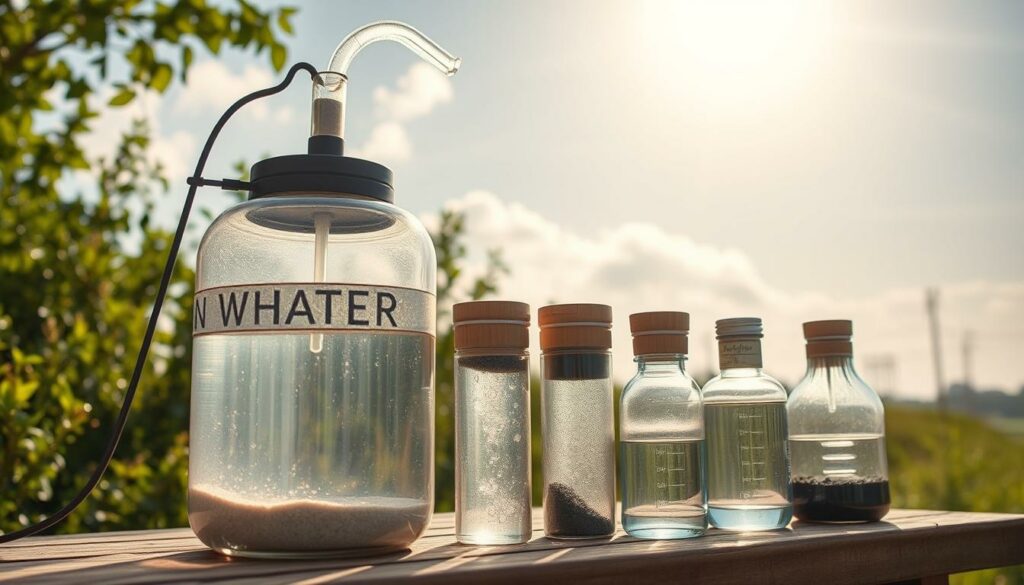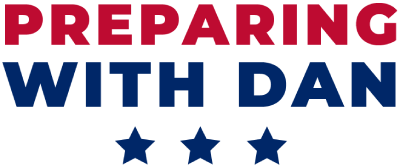In emergencies, having safe drinking water is key. Natural disasters and power outages can break down water systems. So, it’s vital to know how to purify water quickly.
Methods like boiling, using bleach, and survival water filters are lifesavers. They help keep you and your family safe. Learning these techniques can make you more prepared for tough times.
Key Takeaways
- Boil water for 3 to 5 minutes; at high altitudes, add 1 minute per 1,000 feet.
- Add 16 drops of bleach per gallon of water; wait 30 minutes before use.
- Use survival water filters for efficient emergency filtration.
- Store treated water in clean, covered containers.
- Never use contaminated water for food preparation or cleaning.
Understanding the Importance of Water Purification
Water purification is key to keeping us safe and healthy, more so in emergencies. Having clean water is not just a need; it’s a basic right. We’ll look into why purifying water is vital, the dangers of dirty water, and how it affects our health.
Why Clean Water is Essential
Clean water is vital for drinking, cooking, and staying clean. It’s essential for public health and stopping diseases like cholera. The United Nations says 2.1 billion people lack safe drinking water at home, showing the need for purification.
Clean water helps with digestion, reduces stomach issues, and keeps skin healthy. It keeps our body’s pH balance right and removes harmful substances.
Consequences of Contaminated Water
Dirty water poses serious health risks. It can carry harmful bacteria, viruses, and toxins, causing severe diseases. Every year, unsafe water causes 2.2 million deaths from diseases like cholera.
Drinking untreated water can lead to serious illnesses like diarrhea. This illness causes 88% of the world’s four billion cases each year. It also kills about 525,000 children under five annually.
Impact on Health and Safety
The role of water purification in health and safety is huge. Waterborne diseases are a big burden on health systems worldwide. Purification methods like chlorination and UV treatment can kill 99.99% of harmful microbes, making water safer.
Investing in water purification can save money on bottled water and healthcare costs. Drinking clean water boosts our immune system and lowers the risk of deadly diseases.
Common Water Contaminants
Keeping your water clean is key, even in emergencies. It’s important to know what can pollute water to stay healthy.
Biological Contaminants
Water can get contaminated with harmful germs like bacteria and viruses. These include E. coli and Legionella, which can cause serious health problems. Symptoms can range from diarrhea to headaches.
These germs can make you very sick, even deadly. Using a UV system can kill these germs. Boiling water is another quick fix, but it might make other harmful substances worse.
Chemical Pollutants
Water can also have harmful chemicals like heavy metals. These include mercury and lead, which are very dangerous. They can cause long-term health issues and even increase cancer risk.
New contaminants like medicines and personal care products are also found in water. The EPA says using water softeners and reverse osmosis systems is best to remove these.
Physical Impurities
Sediment in water, like sand, can make it look cloudy. While not as dangerous as germs or chemicals, it can hide other harmful stuff. This makes the water look bad and can be unhealthy.
Filters can help remove sediment. This makes the water clearer and safer to drink.
| Contaminant Type | Examples | Health Risks | Effective Treatment |
|---|---|---|---|
| Biological | E. coli, Legionella, Giardia | Diarrhea, vomiting, headaches, fatigue | UV purification, boiling |
| Chemical | Mercury, lead, arsenic | Nausea, abdominal pain, cancer risk | RO systems, water softeners |
| Physical | Silt, sand | Reduced water clarity, possible harboring of other contaminants | Sediment filters, activated carbon filters |
Emergency Water Supply Sources
In emergencies, having a reliable water supply is key. Knowing where to find emergency water and how to store it safely is important. Here’s how to make sure you have safe water when you need it.
Natural Sources to Consider
Nature has many sources for emergency water, like rain, streams, and lakes. But, it’s important to check the water quality first. Streams and lakes might look clear, but they can have hidden contaminants.
Always purify water from natural sources before drinking it. Boiling water for one minute kills most germs. At high elevations, boil for three minutes instead.

- Gravel filters out large particles.
- Sand catches smaller particles.
- Activated charcoal removes chemicals and small particles.
Creating a Simple Filter
A DIY homemade water filter can be made in 30-60 minutes for little to no cost. Here’s how:
- Cut the bottom off a large plastic soda bottle.
- Layer it with cotton balls, sand, gravel, and charcoal in order.
- Pour dirty water through the top and collect clean water at the bottom.
This setup removes big and small particles. But, it’s best to add more steps to make sure the water is safe.
Making a Solar Distiller
Another option is a DIY solar distiller. It uses the sun to purify water through distillation. You need simple items and can set it up quickly.
- Use a large bowl and a cup or smaller bowl inside it.
- Put contaminated water in the large bowl, making sure it doesn’t spill into the smaller bowl.
- Cover it with plastic wrap, securing it tightly.
- Put a small weight on the plastic wrap over the smaller bowl to create a slope.
- Leave it in the sun for a few hours.
The sun will make the water evaporate. It will condense on the plastic wrap and drip into the smaller bowl, giving you clean water.
Using household items for water purification is effective and sustainable in emergencies. Whether you choose homemade water filters or a DIY solar distiller, both are practical ways to have safe drinking water.
Water Purification Kits and Tools
Having clean water is key in emergencies. Keeping emergency water filtration kits and top water purification tools ready is smart. These tools help make water safe to drink when you need it most.
Essential Items to Include
Emergency water kits need various items to purify water well. Key parts include:
- Water purification tablets, like Aquatabs, which fight off giardia cysts, bacteria, and viruses.
- Water containers, such as the 5-gallon collapsible container found in the Aqua Kit.
- Microfilter systems like the KATADYN Hiker Microfilter, known for being portable and effective.
- Emergency water storage solutions, such as Water Preserver and Mainstay emergency water pouches.
Popular Brands to Consider
Many trusted brands make top water purification tools:
- KATADYN: Famous for their Hiker Microfilter, they offer quality portable filters.
- Puravai: Their emergency water containers last up to 20 years.
- EmergencyKits.com: With an A+ rating from the Better Business Bureau, they focus on quality and service.
- ITS: They have reliable water test kits, like the ITS Complete Water Quality Test Kit and the ITS Home Water Quality Test Kit.
How to Use Emergency Kits
Using emergency water kits right is key to safe drinking water. Here’s how to use them:
- Read Instructions: Start by reading the kit’s instructions carefully. Each brand has its own way of doing things.
- Treat the Water: Follow the directions for water purification tablets. For example, Aquatabs need to be mixed with water and waited for 30 minutes.
- Filtration: If you have a microfilter like the KATADYN Hiker, set it up as instructed. Make sure all parts fit together right.
- Storage: Keep your purified water in clean, special containers. This way, it’s ready for emergencies.
By using emergency water kits and knowing how to use them, you can keep drinking water safe in tough times.
Preparing for Water Purification Emergencies
Having a reliable source of clean water during emergencies is key. You need a good plan, to educate your family, and to have the right supplies. These steps are essential for being ready.
Creating an Emergency Plan
It’s important to have a clear plan for water emergencies. Choose places to store water and purification supplies that are easy to reach. You should have one gallon of water per person per day for two weeks.
Remember to use safe storage methods. For example, Water Preserver Concentrate can treat up to 55 gallons for five years.
Educating Your Family
Teaching your family about water purification is critical. Show them how to use purification tablets like Aquatabs, which make water safe in 30 minutes. Also, teach them about portable solutions like the Katadyn Hiker Micro Filter or the WaterBasics Emergency Straw Filter.
Regular practice helps build confidence. Make sure everyone knows what to do in an emergency.
Stocking Up on Supplies
Being prepared means having the right tools and supplies. Consider the Aqua Kit Pro, which has 30 items in a 3.5-gallon bucket. Also, get emergency water containers like Mainstay pouches (5-year shelf life) or Puravai bottles (20-year shelf life).
Don’t forget to include Water Preserver Concentrate and Aquatabs in your kit. Update your emergency supply checklist often and replace stored water every six months.
| Product | Features | Shelf Life |
|---|---|---|
| Aquatabs | Purification tablets for quick use | 30 minutes |
| Water Preserver Concentrate | Treats up to 55 gallons | 5 years |
| Aqua Kit Pro | Includes 30 items | Varies |
| Mainstay Emergency Water Pouches | Compact and durable | 5 years |
| Puravai Emergency Water Containers | High durability | 20 years |
| Katadyn Hiker Micro Filter | Best-selling filtration product | N/A |
| WaterBasics Emergency Straw Filter | Ultralight, portable | N/A |
| KATADYN Vario Micro Filter | Three filtration levels | N/A |
| G2O Water Filtration Bottle | Portable filtration | N/A |
By planning for water emergencies and educating your family, you can greatly improve your readiness. Make sure your emergency supply checklist is detailed and updated often. This will help keep everyone safe and prepared.
Conclusion: Stay Safe with Effective Water Purification
Having clean water during emergencies is key. We’ve looked at many ways to purify water, from simple methods like boiling to advanced systems. Each method is important for staying healthy and safe from harmful substances. It’s good to review these methods often to be better prepared.
Recap of Key Points
We talked about why knowing about water contaminants is important. Clean water is essential for staying healthy, even more so in emergencies. Water purification methods can remove almost all harmful substances, keeping families safe.
Gravity-fed filters and solar-powered purifiers work well without electricity. Chemical disinfection tablets can quickly help in crisis situations.
Encouragement to Practice Techniques
Practicing water purification can save lives by stopping waterborne diseases. Test your water sources often to find and fix problems. Teach your family how to use purification tools and make a plan for emergencies.
Having the right supplies and knowing how to use them makes you more resilient. This ensures water safety in any situation.
Final Thoughts on Water Safety
Water safety is critical for survival, and good purification methods are essential. Being informed and ready helps individuals and families face emergencies with confidence. Keep practicing and improving these methods to stay safe in the future.
Ensuring water safety not only keeps people healthy but also makes communities stronger and more sustainable.
Source Links
- https://biotech.law.lsu.edu/cphl/practice/water.htm
- https://cnrh.cnic.navy.mil/Portals/79/PMRF_Barking_Sands/Documents/Emergency Water Purification.pdf?ver=CSImv_ZnOGD3rpK4thcrtg==
- https://www.britannica.com/topic/water-purification
- https://trityenviro.com/bd/understanding-the-importance-of-water-purification/
- https://aquacarewater.com/importance-of-water-treatment-purification/
- https://wqa.org/learn-about-water/common-contaminants/
- https://www.freshwatersystems.com/blogs/blog/types-of-drinking-water-contaminants-and-how-to-remove-them?srsltid=AfmBOopvp53ofv5zf2aJA_dv-KnmJ2ENtpXggNWQfk2sq8p2tybQW45D
- https://doh.wa.gov/sites/default/files/legacy/Documents/Pubs//331-115.pdf
- https://www.cdc.gov/water-emergency/about/index.html
- https://www.cdc.gov/water-emergency/about/how-to-create-and-store-an-emergency-water-supply.html
- https://atlas-scientific.com/blog/water-purification-methods/?srsltid=AfmBOoq5F-s0vq0uagfU50NohYoznVu-Zn86Py2qD1q2wYGl8_F5RyQX
- https://www.schultzsoftwater.com/blog/4-methods-to-purify-your-water
- https://en.wikipedia.org/wiki/Water_purification
- https://azdeq.gov/awp
- https://h2oglobalnews.com/top-advanced-water-treatment-technologies/
- https://www.rusco.com/blog/diy-water-filtration-cost-effective-methods-for-purifying-your-water
- https://www.h2odistributors.com/info/how-to-make-a-water-filter/?srsltid=AfmBOoq8Rc9vpjEwAthaDU1cGF6OX2Y04CcWM_se9tr8vwBuHjT8aTFB
- https://www.generationgenius.com/activities/water-quality-and-distribution-activity-for-kids/
- https://www.emergencykits.com/emergency-water/water-purification?srsltid=AfmBOorMUPu3rM6S1ZUEaPindch4j86z3I4Bf9JzRKLQUp9sKHgIK7aQ
- https://www.home-water-purifiers-and-filters.com/water-test.php?srsltid=AfmBOopAqO8tgLPC_ofMCQwOoPUbSiS7nmVYEPkM7Re4hcBZ_kP0OFBb
- https://www.laboratory-equipment.com/water-purity-systems.php?srsltid=AfmBOoovXrFwnkSyvRB-upTltnym90qX2PWdHmvwLNOocxgI5McR_uxY
- https://www.emergencykits.com/emergency-water/water-purification?srsltid=AfmBOoqmVdKeUGUFIRBqVPpiUlV4J_NmnWypBtMLIYK7PqTQ71YQvFJR
- https://doh.wa.gov/emergencies/be-prepared-be-safe/severe-weather-and-natural-disasters/water-purification
- https://www.mirasafety.com/blogs/news/water-purification?srsltid=AfmBOooRmJyko-NkFPEBkQmdJ2HaYWzHVQfc27flMGANeBE-nrOPmVyh
- https://drinkprime.in/blog/water-purification/?srsltid=AfmBOopuidtznG6wsJZFqIRl9ODoTrSa5jU010fR16Y1-eYgC-iqkZao
- https://www.123helpme.com/essay/Water-Purification-Conclusion-429214

